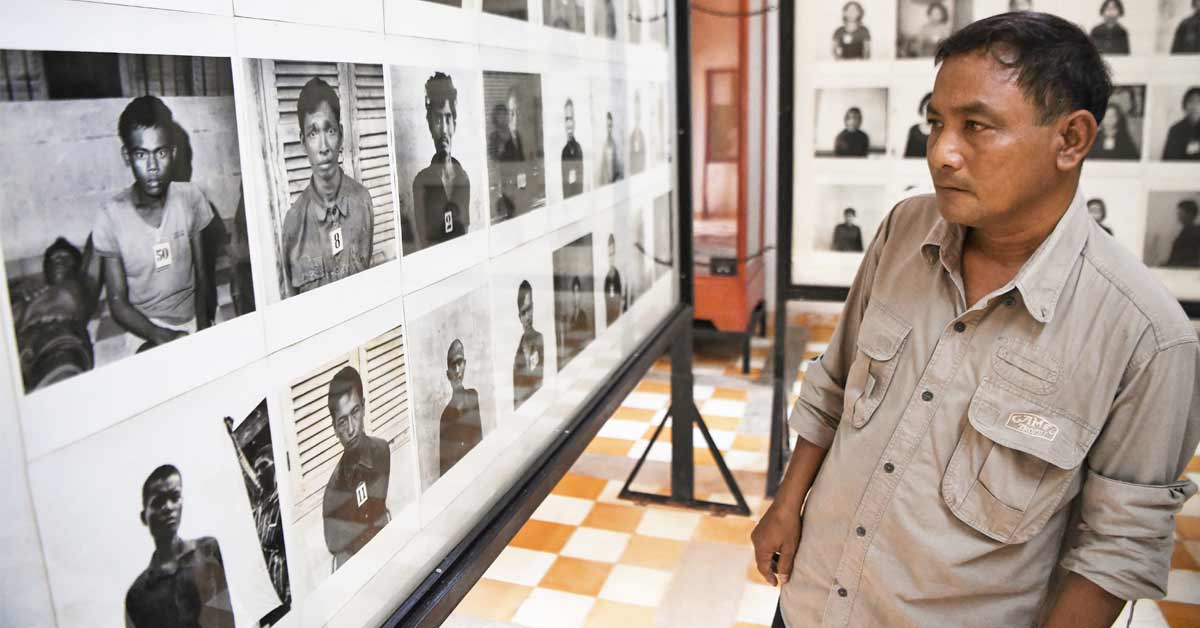Authorities in Cambodia have criticised an artist after he altered photos of victims of the Khmer Rouge genocide.
Irish artist Matt Loughrey colourised images of photos taken in the notorious Tuol Sleng prison. Smiles were reportedly added to some faces.
In a VICE article, which was later removed, Loughrey said he had wanted to humanise the victims.
The brutal regime, in power from 1975-1979, claimed the lives of up to two million people.
Cambodia's culture ministry said the altering of the images affected "the dignity of the victims" and called for both, Loughrey and VICE to remove them.
It said that the Tuol Sleng Genocide Museum was the lawful owner of the images. The ministry vowed to take legal action if "Matt Loughrey does not comply" with the request.
"We urge researchers, artists and the public not to manipulate any historical source to respect the victims," it said.
Loughrey told the media he could not comment until he had spoken to VICE.
In a statement on its site, VICE said: "The article included photographs of Khmer Rouge victims that Loughrey manipulated beyond colourisation.
"The story did not meet the editorial standards of VICE and has been removed. We regret the error and will investigate how this failure of the editorial process occurred."
What Did The Images Show?
Loughrey colourised images of victims from the infamous S-21 prison in the capital Phnom Penh, where more than 15,000 people were sent to their deaths.
These images were then featured in a profile piece in VICE.
Loughrey said the project had seen a "huge response" and added that he was talking to the museum about making the images accessible to everyone.
When asked by VICE magazine about the smiles, he said that women appeared to smile more than the men in the photos he had seen.
"I think a lot of that has to do with nervousness," he said. "Also – and I'm making an educated guess – whoever was taking the photographs and who was present in the room might have spoken differently to the women than they did the men."
The article made no mention of smiles being added.
What Has The Reaction Been?
On Saturday, a number of people on Twitter posted the alleged original images alongside the colourised photo, saying the smiles had been added.
This led to a huge backlash in Cambodia.
One tweeter, Munthit Ker, wrote: "No words can ever fully describe the dreadful feelings hidden behind those faces who knew they would soon be marched to the mass graves. But here they were transformed into celebratory, smiley portraits for an artful show off. Inconsiderate and offensive!"
One woman named Lydia said she was the niece of one of the people in Loughrey's photos. She said that his smirk had not been edited but said information Loughrey gave about him in the interview with VICE was false.
The article stated her uncle had been a farmer who was electrocuted and set on fire.
"We don't know the exact way in which he died, and there may be a record of that we haven't seen," she tweeted. "But the rest is false: he was not a farmer, but a primary school teacher. It's impossible for Loughrey to have been in contact with his son, because his only children also died."
"Responsible journalism is crucial, especially when it concerns the retelling of stories of real victims of a terrible genocide. These people have families and loved ones," she added.
The Tuol Sleng Genocide Museum, which is on the site of the former prison, said that the altered photos "seriously affect the dignity of the victims".
Who Were The Khmer Rouge?
The regime led by Pol Pot tried to take Cambodia back to the Middle Ages, or "Year Zero", forcing millions of people from the cities to work on communal farms in the countryside.
They at first targeted "intellectuals" – often identified as those who wore glasses or spoke a foreign language – and those connected to the old, United States (US)-backed regime that they overthrew. But their paranoid leaders later began to see "enemies" everywhere.
Ethnic Vietnamese and Cham Muslims in Cambodia were also targeted. Many of the Khmer Rouge's victims died from starvation, disease and overwork.
The regime was ousted in 1979 by Vietnamese troops, but the Khmer Rouge leaders escaped and continued to resist the new, Vietnamese-backed government from areas along the Thai-Cambodia border. – BBC
Related Articles:
